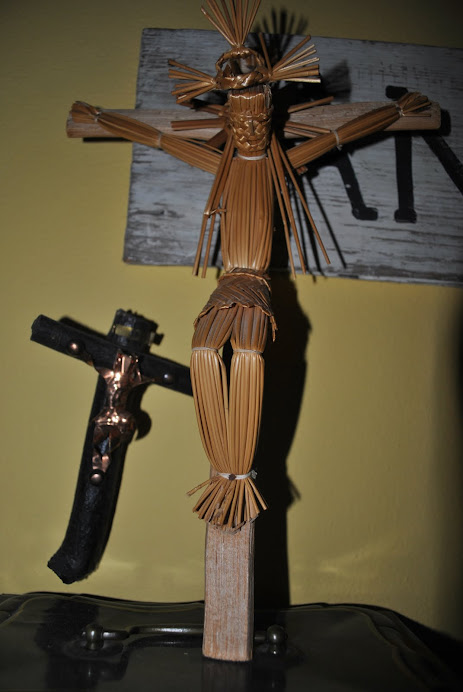Italian-Style Devotional Art Collection:... History of Wax Dolls
History of Wax Dolls
I was at a church tag sale when I happened upon the most beautiful statue I’d ever seen. Carved of wood, it depicted a black woman wearing a vibrant blue dress with the heads of cherubim around her feet. On her head rested a gold metal crown.
“How much” I asked the elderly woman standing nearby as I reverently eyed the 18-inch-tall statue, running my fingers over the intricately carved robe the statue wore.
“Oh, it’s not for sale,” she said. I looked up at her, disappointed, wondering why the statue would be on display if it were not for sale. “It can’t be sold because it’s been blessed by a priest. You can give me a donation for her.”
Being Catholic, I was familiar with the practice of not selling items that were blessed. If you sell them, the blessing does not remain with the item. Being ignorant of the value of such a statue, I offered the woman a $20 donation, thinking that was a fair price. She accepted. I should have offered 10 times that amount.
After some research, I discovered the statue is an excellent Spanish colonial hand-carved example of the
Black Madonna
, or Our Lady in Czestochawa, Poland. The image is sometimes called Our Lady of Jasna Gora after the name of the monastery site in which it has been kept for six centuries. Its origins are unknown. According to legend, it was created by
St. Luke the evangelist 
who painted the portrait of the Blessed Virgin on the cedar table at which she had taken her meals.
St. Helena
, the mother of
Emperor Constantine
, located the portrait and had it transported to Constantinople in the fourth century. After there for five centuries, it made its way to Poland where it came into the possession of St. Ladislaus in the 15th century. St. Ladislaus was determined to protect the image from an attack by the Tartars so he took it across country. During the journey, he stopped at Czestochowa for the night and placed the portrait in a small wooden church named for the Assumption. The following morning, he put the portrait in the wagon to proceed on his journey but the horses refused to move. The portrait had claimed its home.
I’ve since seen similar statues of the Black Madonna selling for thousands of dollars. But my statue has an honored place in my home amongst a growing collection of saint statues known as santos or bultos.
After acquiring my Black Madonna, I became fascinated by these beautiful pieces of art. Some in my collection are newer
folk art 
pieces and some are hundreds of years old.
Like many of my collectibles, I began picking them up for a song before they became highly collectible. Today, I couldn’t afford to purchase my collection.
My collection includes various saints including an Infant of Prague with real human hair, carved wooden
Simon and Peter 
statues with ivory faces, and a wood-carved St.
Francis of Assisi 
with articulated arms.
I love the simple painted folk art wood pieces made in
Guatemala
and Peru depicting St. Francis and Our Savior. There is something so beautiful about their crude simplicity and bright colors.
My greatest find, however, is a collection of 15 6-inch wax saints with cloth dress, cotton hair and beards, many accompanied by the saints’ relics. They were most likely made in Germany where wax dolls such as these are common in nativity scenes. I’ve never seen another set of saint dolls. I donated $85 for the set.
In South America, residents will create
home altars 
around santos at which they will pray for the saint to intercede on their behalf. Contrary to some opinion, Catholics don’t pray to saints. We ask saints to pray for us just as you’d ask a friend to pray on your behalf. I wonder about all the requests, large and small, these santos have heard throughout the years.
Catholics are known for their love of great devotional art, i.e., the
Sistine Chapel
. Even the most modest ancient Catholic churches were filled with elaborate statues and stained glasswork.
That love of art carried over into the home with collections of saints and devotional wall art that included elaborately carved
Black Forest 
crucifixes from Germany, intricate copper engravings of scenes from the Bible and richly decorated leather-bound
Douay Rheims Bibles
.
I’ve been lucky enough to have acquired quite a few pieces of devotional art, which gives me double pleasure for its beauty and spirituality.
Remembering the
Infant of Prague 
statues in their fancy handmade gowns that my grandmother owned, I’ve also become a collector of these more kitschy baby Jesus figures with their satin, sequins and jeweled crowns.
I didn’t realize these were a hot collectible until I saw them displayed in Country Living magazine. I thought I was the only one attracted to these statues from the ‘50s and ‘60s.
It just goes to show, there’s a collector for everything.







